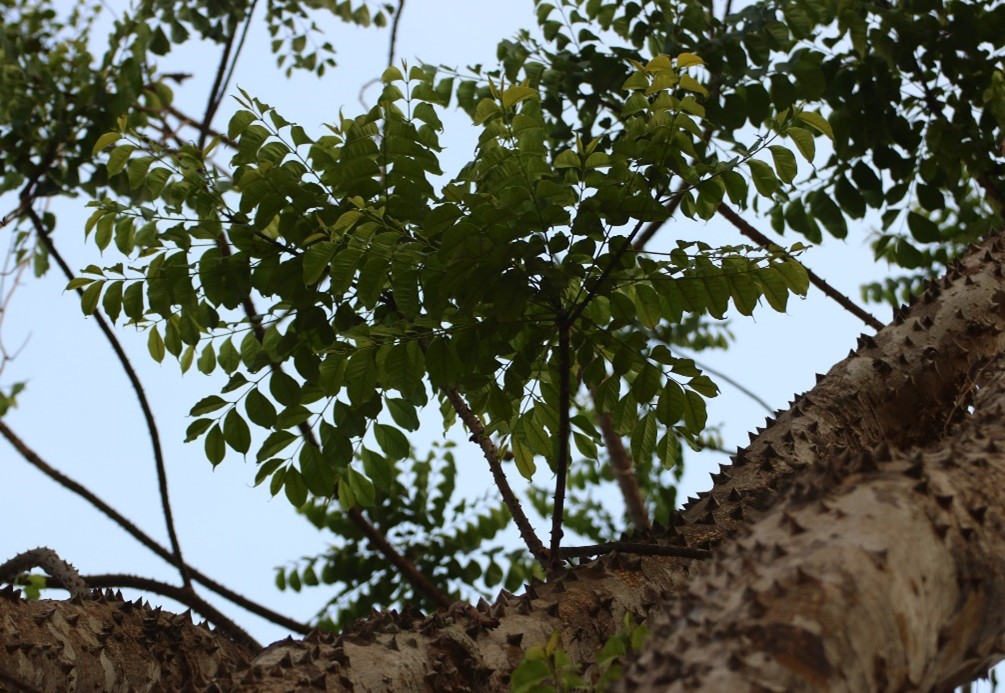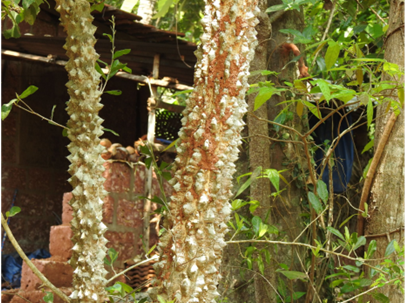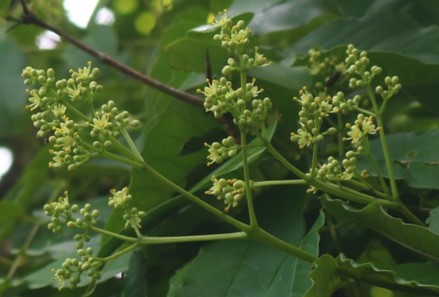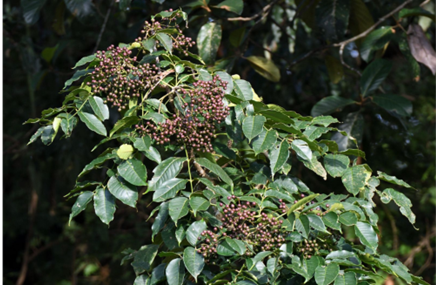ເລກລຳດັບທີ: 37
ລະດັບການຮວບຮວມຂໍ້ມູນ: ເກີອບສົມບູນ
ປັບປູງຄັ້ງລ່າສຸດ: 2024-10-14
ໝາກແຄ່ນ
Cape yellowwood
Zanthoxylum rhetsa (Roxb.) DC.
ພືດ
ໄມ້ຢືນຕົ້ນ
ໄມ້ພຸ່ມ
×
ຊື່ທ້ອງຖີ່ນ:
ເປຼະຍອງ (ກຶມມຸ) ( Indian ivy-rue)
ຊື່ພ້ອງ
:
Fagara budrunga Roxb.
Fagara parviflora (Benth.) Engl.
Fagara rhetsa Roxb.
Lacuris illicioides Buch.-Ham.
Tipalia limonella Dennst.
Zanthoxylum budrunga (Roxb.) DC.
Zanthoxylum crenatum Wall.
Zanthoxylum limonella (Dennst.) Alston
Zanthoxylum minahassae Koord.
Zanthoxylum oblongum Wall.
Zanthoxylum parviflorum Benth.
Zanthoxylum rhetsum (Roxb.) St.-Lag.
Fagara parviflora (Benth.) Engl.
Fagara rhetsa Roxb.
Lacuris illicioides Buch.-Ham.
Tipalia limonella Dennst.
Zanthoxylum budrunga (Roxb.) DC.
Zanthoxylum crenatum Wall.
Zanthoxylum limonella (Dennst.) Alston
Zanthoxylum minahassae Koord.
Zanthoxylum oblongum Wall.
Zanthoxylum parviflorum Benth.
Zanthoxylum rhetsum (Roxb.) St.-Lag.
ຊື່ສະກຸນ:
Rutaceae
ຊະນິດໃກ້ຄຽງ:
ໝາກໝາດ/ Winged Prickly Ash
ໝາກໝາດແດງ/ Mark Mard daeng
ຫວ້ານດູກໄກ່/ Van Douk Kai
ຊາຫຼີວ/ Sa Liew
ໝາກໝາດແດງ/ Mark Mard daeng
ຫວ້ານດູກໄກ່/ Van Douk Kai
ຊາຫຼີວ/ Sa Liew
ບັນຍາຍລັກສະນະທາງພືດສາດ:
ພືດຊະນິດສາມາດຂະາຫຍຕົວເປັນໄມ້ຟຸ່ມ ຫຼື ໄມ້ຢືນຕົ້ນ ໂດຍສູງຮອດ 26 ມ. ກິ່ງແກ່ຂອງພືດຊະນິດນີ້ຈະມີໜາມແຫຼມໜາ, ໜາເຫຼົ່ານີ້ສາມາດໃຊ້ເປັນກົນໄກໃນການປ້ອງກັນຕົວຈາກສັດຕູພືດ.
ໃບໝາກແຄ່ນ ເປັນໃບປະສົມ, ເຊິ່ງມີໃບຍ່ອຍຈຳນວນຫຼາຍຈັບຢູ່ກົງກັນຂ້າມຂອງແກ່ນກາງໃບ, ຍາວ 4 ຫາ 13 ຊມ. ແລະ ກວ້າງ 1,5 ຫາ 5 ຊມ. ເຮັດໃຫ້ມີັລກສະນະເປັນຮູບຮີ.
ດອກອອກເປັນຊໍ່, ຊຶ່ງມີດອກຍ່ອຍຂະໜາດນ້ອຍ, ສີຂາວ ຫຼື ສີເຫຼືອງ.
ຫຼັງຈາກອອກດອກແລ້ວ ຈະອອກໝາກທີ່ມີລັກສະນະກົມ, ສີແດງ ຫຼື ສີນ້ຳຕານ, ໝາກເຫຼົ່ານີ້ຖືເປັນລັກສະນະເດັ່ນຂອງພືດຊະນິດ ແລະ ສາມາດດຶງດູດສັດປ່າໄດ້ເປັນຈຳນວນຫຼາຍ.
ແຫຼ່ງທີ່ມາ: [1]
ໃບໝາກແຄ່ນ ເປັນໃບປະສົມ, ເຊິ່ງມີໃບຍ່ອຍຈຳນວນຫຼາຍຈັບຢູ່ກົງກັນຂ້າມຂອງແກ່ນກາງໃບ, ຍາວ 4 ຫາ 13 ຊມ. ແລະ ກວ້າງ 1,5 ຫາ 5 ຊມ. ເຮັດໃຫ້ມີັລກສະນະເປັນຮູບຮີ.
ດອກອອກເປັນຊໍ່, ຊຶ່ງມີດອກຍ່ອຍຂະໜາດນ້ອຍ, ສີຂາວ ຫຼື ສີເຫຼືອງ.
ຫຼັງຈາກອອກດອກແລ້ວ ຈະອອກໝາກທີ່ມີລັກສະນະກົມ, ສີແດງ ຫຼື ສີນ້ຳຕານ, ໝາກເຫຼົ່ານີ້ຖືເປັນລັກສະນະເດັ່ນຂອງພືດຊະນິດ ແລະ ສາມາດດຶງດູດສັດປ່າໄດ້ເປັນຈຳນວນຫຼາຍ.
ແຫຼ່ງທີ່ມາ: [1]
ນິເວດວິທະຍາ
ເຂດກະຈາຍພັນທົ່ວໂລກ:
Native to Native to Andaman Is., Assam, Bangladesh, Borneo, Cambodia, East Himalaya, India, Jawa, Laos, Lesser Sunda Is., Malaya, Myanmar, New Guinea, Northern Territory, Queensland, Solomon Is., Sri Lanka, Sulawesi, Sumatera, Vietnam, Western Australia. [6]
Global distribution of Zanthoxylum rhetsa between 2003 to 2024. Source: [2]
Global distribution of Zanthoxylum rhetsa between 2003 to 2024. Source: [2]
ເຂດກະຈາຍພັນໃນລາວ
:
ເຂດພູສູງພາກເໜືອຂອງລາວ
ລຽບແມ່ນ້ຳຂອງພາກເໜືອ
ເຂດພູສູງສາຍພູຫຼວງ ແລະ ເຂດພູພຽງແຂວງຊຽງຂວາງ
ທົ່ງພຽງວຽງຈັນ
ເຂດສາຍພູຫຼວງພາກເໜືອ
ເຂດລຽບແມ່ນ້ຳຂອງພາກໃຕ້
ພູພຽງບໍລິເວນ
ລຽບແມ່ນ້ຳຂອງພາກເໜືອ
ເຂດພູສູງສາຍພູຫຼວງ ແລະ ເຂດພູພຽງແຂວງຊຽງຂວາງ
ທົ່ງພຽງວຽງຈັນ
ເຂດສາຍພູຫຼວງພາກເໜືອ
ເຂດລຽບແມ່ນ້ຳຂອງພາກໃຕ້
ພູພຽງບໍລິເວນ

ເຂດກະຈາຍພັນຕາມພູມສັນຖານ
:
ປ່າດົງດິບ
ປ່າປະສົມປ່ຽນໃບ
ປ່າໂຄກ
ປ່າເຫຼົ່າອ່ອນ
ປ່າເຫຼົ່າແກ່
ທົ່ງຫຍ້າ
ປ່າປະສົມປ່ຽນໃບ
ປ່າໂຄກ
ປ່າເຫຼົ່າອ່ອນ
ປ່າເຫຼົ່າແກ່
ທົ່ງຫຍ້າ
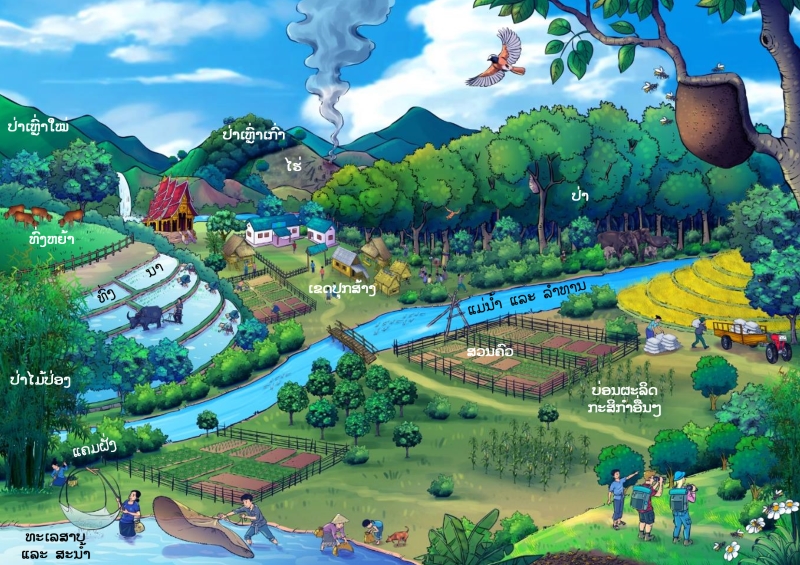
ສະເພາະຖິ່ນໃນລາວ:
ພື້ນເມືອງ
ຮຸກຮານ
:
ບໍ່ຮຸກຮານ
ສະຖານະພາບການອະນູຮັກ IUCN
:
ມີຄວາມສ່ຽງໜ້ອຍສຸດ
ສະຖານະພາບການອະນຸຮັກແຫ່ງຊາດລາວ
:
ບັນຊີທີ່ III: ຊະນິດພັນປະເພດທົ່ວໄປ
ການນຳໃຊ້
ປະເພດການນຳໃຊ້:
ອຸປະກອນ ແລະ ເຄື່ອງມື
ອາຫານ
ເຄື່ອງດື່ມ
ພືດເປັນຢາ
ອາຫານ
ເຄື່ອງດື່ມ
ພືດເປັນຢາ
ບັນຍາຍການນຳໃຊ້:
ອາຫານ: ໝາກຖືກນຳມາໃຊ້ໃນອາຫານຕ່າງໆ, ມັກບົດປະສົມກັບຊີ້ນສັດ ຫຼື ປາ ຈາກນັ້ນນຳໄປປີ້ງ ຫຼື ໃຊ້ປະສົມໃນແຈ່ວ, ລວມທັງການກຽມອາຫານອື່ນໆ. ໃບອ່ອນຍັງໃຊ້ເປັນເຄຶ່ອງປຸ່ງ ຫຼື ຜັກໄດ້ອີກດ້ວຍ [5]. ໝາກສົດໃຊ້ດອງໃນນໍ້າປາ ແລະ ຮັກປະທານເປັນຜັກເຄື່ອງຄຽງກັບລາບ. ໝາກແຫ້ງ ແລະ ແກ່ນ ໃຊ້ເປັນເຄື່ອງເທດ ແລະ ເຄື່ອງປຸ່ງ ໂດຍຈະປະສົມລົງໃນແຈ່ວ, ລາບ ຫຼື ເອາະ ເນື່ອງຈາກມີກິ່ນຫອມ ແລະ ຣົດຊາດເຜັດ ສ່ວນປະສົມນີ້ບໍ່ພຽງແຕ່ຊ່ວຍດັບກິ່ນຄາວຂອງຊີ້ນເທົ່ານັ້ນ ແຕ່ຍັງເພີ່ມຣົດຊາດໂດຍລວມຂອງອາຫານໃຫ້ແຊບຂື້ນອີກດ້ວຍ,ນອກຈາກນີ້ໃບອ່ອນ ແລະ ຍອດຍັງສາມາດຮັບປະທານເປັນຜັກໄດ້ອີກດ້ວຍ. [7]
ເຄື່ອງດືມ: ໃບເປັນສ່ວນປະສົມໃນການຜະລິດໄວນ໌ຂາວ. [5]
ສະມຸນໄພ: ໃນຢາແຜ່ນບູຮານໝາກແຄ່ນ ມີຊື່ສຽງໃນດ້ານປະສິດທິພາບໃນການຮັກສາພະຍາດຄໍພອງ ແລະ ປັດຈຸບັນໃຊ້ເປັນຢາຊາໃນຊ່ອງປາກ.ໃນຢາແຜນບູຮານສ່ວນຕ່າງໆຂອງໝາກແຄ່ນໃຊ້ຮັກສາແຂ້ວພຸ, ອາການວຽນຫົວ, ທ້ອງອືດ, ໄຂ້ມາລາເຣຍ, ການຕິດເຊື້ອທາງເດີນປັດສະວະ, ພະຍາດຂໍ້ອັກເສບ, ໃຊ້ຂັບປັດສະວະ ລວມທັງອາການເຈັບທ້ອງ ແລະ ຖອກທ້ອງ, ສານປະກອບເຫຼົ່ານີ້ຍັງມີຄຸນສົມບັດຕ້ານແບັກທິເຣຍ, ຕ້ານການອັກເສບ, ແກ້ປວດ ແລະ ຕ້ານອານຸມູນອິດສະຫຼະ ລວມທັງມິລິດຕ້ານຈຸລັງເມັດເລືອດແຂງຕົວ ແລະ ປົກປ້ອງແສງ [5]. ໃບນຳມາບົດໃຫ້ະອຽດໃຊ້ຮັກສາອາການເຈັບແຂ້ວ, ແກ່ນນຳມາກິນແກ້ອາການວຽນຫົວ, ຊ່ວຍຍ່ອຍອາຫານ, ບຳລຸງຫົວໃຈ, ຂັບແກສໃນລຳໄສ້, ກະຕຸ້ນປັດສະວະ, ບຳລຸງຮ່າງກາຍ ແລະ ບັນເທົາອາການທ້ອງຜູກ. ຮາກ ແລະ ລຳຕົ້ນສາມາດຕົ້ມດືມເພື່ອຊ່ວຍຂັບແກສໃນລຳໄສ້, ບັນເທົາອາການວຽນຫົ ແລະ ໜ້າມືດຕາລາຍ ແລະ ຂັບປະຈຳເດືອນໃນແມ່ຍິງ, ນອກຈາກນນີ້ຮາກທີ່ບັດແລ້ວ ຍັງສາມາດນຳມາທາແຜ ຫຼື ບໍລິເວນທີ່ສັດກັດເພື່ອຮັກສາ. [7]
ເຄື່ອງມື ແລະ ອຸປະກອນ: ໄມ້ສີເຫຼືອງອ່ອນຖືກນຳມາໃຊ້ເປັນເວລາດົນໃນການໃຊ້ເປັນດ້າມເຄື່ອງມື ເຊັ່ນ ຝັກດາບ ແລະ ຮູບປັ້ນ. [5]
ເຄື່ອງດືມ: ໃບເປັນສ່ວນປະສົມໃນການຜະລິດໄວນ໌ຂາວ. [5]
ສະມຸນໄພ: ໃນຢາແຜ່ນບູຮານໝາກແຄ່ນ ມີຊື່ສຽງໃນດ້ານປະສິດທິພາບໃນການຮັກສາພະຍາດຄໍພອງ ແລະ ປັດຈຸບັນໃຊ້ເປັນຢາຊາໃນຊ່ອງປາກ.ໃນຢາແຜນບູຮານສ່ວນຕ່າງໆຂອງໝາກແຄ່ນໃຊ້ຮັກສາແຂ້ວພຸ, ອາການວຽນຫົວ, ທ້ອງອືດ, ໄຂ້ມາລາເຣຍ, ການຕິດເຊື້ອທາງເດີນປັດສະວະ, ພະຍາດຂໍ້ອັກເສບ, ໃຊ້ຂັບປັດສະວະ ລວມທັງອາການເຈັບທ້ອງ ແລະ ຖອກທ້ອງ, ສານປະກອບເຫຼົ່ານີ້ຍັງມີຄຸນສົມບັດຕ້ານແບັກທິເຣຍ, ຕ້ານການອັກເສບ, ແກ້ປວດ ແລະ ຕ້ານອານຸມູນອິດສະຫຼະ ລວມທັງມິລິດຕ້ານຈຸລັງເມັດເລືອດແຂງຕົວ ແລະ ປົກປ້ອງແສງ [5]. ໃບນຳມາບົດໃຫ້ະອຽດໃຊ້ຮັກສາອາການເຈັບແຂ້ວ, ແກ່ນນຳມາກິນແກ້ອາການວຽນຫົວ, ຊ່ວຍຍ່ອຍອາຫານ, ບຳລຸງຫົວໃຈ, ຂັບແກສໃນລຳໄສ້, ກະຕຸ້ນປັດສະວະ, ບຳລຸງຮ່າງກາຍ ແລະ ບັນເທົາອາການທ້ອງຜູກ. ຮາກ ແລະ ລຳຕົ້ນສາມາດຕົ້ມດືມເພື່ອຊ່ວຍຂັບແກສໃນລຳໄສ້, ບັນເທົາອາການວຽນຫົ ແລະ ໜ້າມືດຕາລາຍ ແລະ ຂັບປະຈຳເດືອນໃນແມ່ຍິງ, ນອກຈາກນນີ້ຮາກທີ່ບັດແລ້ວ ຍັງສາມາດນຳມາທາແຜ ຫຼື ບໍລິເວນທີ່ສັດກັດເພື່ອຮັກສາ. [7]
ເຄື່ອງມື ແລະ ອຸປະກອນ: ໄມ້ສີເຫຼືອງອ່ອນຖືກນຳມາໃຊ້ເປັນເວລາດົນໃນການໃຊ້ເປັນດ້າມເຄື່ອງມື ເຊັ່ນ ຝັກດາບ ແລະ ຮູບປັ້ນ. [5]
ການປູກ ການລ້ຽງ:
ປູກ ແລະ ທຳມະຊາດ
ລະດູການເກັບກູ້:
ກັນຍາ
ຕຸລາ
ພະຈິກ
ຕຸລາ
ພະຈິກ
ການຕະຫຼາດ ແລະ ຕ່ອງໂສ້ມູນຄ່າ:
ຈາກການນຳໃຊ້ປະໂຫຍດທີ່ຫຼາກຫຼາຍເຮັດໃຫ້ເຮັດໃຫ້ໝາກແຄ່ນມີມູນຄ່າສູງໃນຕະຫຼາດພາຍໃນປະເທດ ແລະ ເປັນທີ່ຕ້ອງການຂອງປະເທດເພືອນບ້ານຫຼາຍຂື້ນ ໂດຍສະເພາະຈີນ ທີ່ນຳເຂົ້າໃນປະລິມານຫຼາຍຂື້ນ. ການເກັບກ່ຽວໝາກແຄ່ນຊ່ວຍກະຕຸ້ນເສດຖະກິດຂອງໝູ່ບ້ານຫຼາຍແຫ່ງທາງພາກເໜືອຂອງລາວໄດ້ເປັນຈຳນວນຫຼາຍ. [5]
ການຄຸ້ມຄອງຈັດການ
ສະພາບໂດຍລວມ:
ການປູກໝາກແຄ່ນມີຢູ່ 2 ວິທີຄື: ການປູກດ້ວຍແກ່ນ ແລະ ການຕໍ່ກິ່ງ.
ການປູກດ້ວຍແກ່ນ: ຊ່ວງເວລາທີ່ເໝາະສົມທີ່ສຸດໃນການເກັບໝາກແຄ່ນເພື່ອປູກແມ່ນເດືອນ ພະຈິກ ຫາເດືອນທັນວາ. [7]
ການຂະຫຍາຍພັນດ້ວຍການປັກຊຳ: ການປູກໝາກແຄ່ນໃນຊ່ວງຕົ້ນລະດູຝົນ ໂດຍປົກກະຕິຄືຊ່ວງປາຍເດືອນ ເມສາ ຫາເດືອນ ພຶດສະພາ ຫຼື ຫຼັງຈາກຝົນຕົກ 2 ຫາ 3 ຄັ້ງ ເມື່ອດິນມີຄວາມຊຸ່ມພຽງພໍ. [7]
ການຄັດເລືອກສາຍພັນ: ເລືອກຜົນສຸກເຕັມທີ່ແລ້ວນຳໄປຕາຫແຫ້ງໃນທີ່ເພື່ອແຍກແກ່ນອອກ. [7]
ການກຽມພື້ນທີ່:
ການຂະຫຍາຍພັນດ້ວຍແກ່ນ:
ການກຽມແກ່ນ: ຫາກຕ້ອງການເລັ່ງການງອກ ໂດຍຈະຕ້ອງທຳລາຍຊັ້ນນ້ຳມັນທີ່ເຄືອບແກ່ນພືດໄວ້ ເຊິ່ງມີຫຼາຍວິທີທີ່ຈະເຮັດໄດ້ ເຊັ່ນ ແຊ່ແກ່ນພັນລົງໃນນ້ຳອຸ່ນ ທີ່ອຸ່ນຫະພູມ 50 ອົງສາ, ເປັນເວລາ 5 ຫາ 10 ນາທີ ຈາກນັ້ນຍ້າຍແກ່ນໝາກແຄ່ນໄປແຊ່ໃນນ້ຳເຢັນເປັນເວລາ 1 ຄືນ ກ່ອນຈະນຳໄປຫວ່ານໃນແປງເພາະພັນ. [7]
ການຫວ່ານແກ່ນ: ເຕີມດິນໃນພາສະນະເພາະພັນໃຫ້ໄດ້ປະມານ 5 ຊມ., ແລ້ວນຳແກ່ນໝາກແຄ່ນທີ່ກຽມໄວ້ຫວ່ານໃຫ້ທົ່ວ ແລ້ວໃຊ້ຄຸຍໝາກພ້າວໂຮຍຄຸມ ໃຫ້ໜາາປະມານ 0,5 ຫາ 1 ຊມ., ນຳນ້ຳມາຫົດໃຫ້ຊຸມ ຈາກນັ້ນໃຊ້ເຟືອງ, ຫຍ້າແຫ້ງ ຫຼື ຖົງພຼາສຕິກຄຸມເພື່ອຮັກສາຄວາມຊຸມ. ຫຼັງຈາກຫວ່ານແລ້ ແກ່ນໝາກແຄ່ນຈະເລີ່ມງອກ 3 ຫາ 4 ອາທິດ ຫຼື ເມື່ອສັງເກດເຫັນໃບແທ້ 2 ໃບ ຈຶ່ງຍ້າຍໄປປູກໃນຖົງເພາະຊຳ. [7]
ການຍ້ານຕົ້ນກ້າລົງໃນຖົງເພາະປູກ: ທຳອິກເຮົາຈະກຽມສວນປະສົມຂອງດິນເພາະປູກ ໂດຍໃຊ້ສ່ວນປະສົມໃນອັດຕາຕໍ່ໄປນີ ດິນ 60%, ຝຸ່ນຄອກ 20% ແລະ ແກບເຜົາ 20% ປະສົມໃຫ້ເຂົ້າກັນດີ ແລ້ວເຕີມສ່ວນປະສົມລົງໃນຖົງເພາະຊຳຂະໜາດ 3,5x7 ຊມ. ຫຼື ໃຫຍ່ກ່ວາ, ແລ້ວຫົດນ້ຳໃຫ້ຊຸ່ມ ຈາກນັ້ນຄ່ອຍໆດຶງຕົ້ນກ້ວາໝາກແຄ່ນອອກໂດໃຊ້ໄມ້ແຫຼມ ແລ້ວລ້າງໃນຊາມນ້ຳໃຫ້ສະອາດກ່ອນຍ້າຍລົງໃນຖົງເພາະປູກີ່ກຽມໄວ້ ຫຼັງຈາກຍ້າຍຕົ້ນກ້າແລ້ວ ໃຫ້ກວດສອບຄວາມຊຸມຫາດິນຍັງມີຄວາມຊຸ່ມຢູ່ ບໍ່ຈຳເປັນຕ້ອງຫົດນ້ຳເພີ່ມ ແຕ່ຖ້າຫາກດິນແຫ້ງ ໃຫ້ຫົດນ້ຳວັນລະຄັ້ງ ໂດຍສະເພາະຕອນເຊົ້າ. [7]
ການກຽມພື້ນທີ່ສຳຫຼັບປູກ:
ການກຽມດິນ: ການກຽມດິນສຳຫຼັບປູກໝາກແຄ່ນ ຂື້ນຢູ່ກັບແຮງງານທີ່ມີຢູ່ ແລະ ສະພາບເສດຖະກິດຂອງຄອບຄົວ ເຊິ່ງມີຢູ່ 2 ວິທີຫຼັກຄື:
• ການໃຊ້ແຮງງານຄົນ: ໝາຍເຖິ່ງການໃຊ້ແຮງງານຄົນໃນການກຳຈັດວັດສະພືດ ແລະ ຕົ້ນໄມ້ຂະໜາດນ້ອຍ ທີ່ບໍ່ຕ້ອງການອອກຈາກພື້ນທີ່ປູກ ໂດຍບໍ່ຈູດຕົ້ນໄມ້ເຫຼົ່ານັ້ນ ແລະ ຍັງຄົງຮັກສາຕົ້ນໄມ້ຂະໜາດໃຫຍ່ໄວ້. [7]
• ເຄື່ອງຈັກ: ອີກທາງເຫຼືອກໜຶ່ງຄືການໃຊ້ເຄື່ງຈັກ ເຊັ່ນລົດໄຖ່ ຄາດ ແລະ ໄຖ່ເພື່ອກຳຈັດເສດສາກພືດອອກຈາກພື້ນທີ່. [7]
ການປັກຫຼັກເພື່ອໝາຍຂຸມ: ໃຊ້ໄມ້ໄຜ່ທີ່ຕັກເປັນດິ້ວ ຫຼື ເປັນທ່ອນ ໂດຍມີເສັ້ນຜ່າສູນກາງ 2 ຊມ. ແລະ ຍາວ 1 ມ., ໂດຍແຫຼມປາຍອີກດ້ານໜຶ່ງ, ຈາກນັ້ນຂຸດຂຸມປູກ ໂດຍເວັ້ນໄລຍະຫ່າງກັນປະມານ 4x4 ມ. ເວັ້ນທາງກັນໄຟຮອບໆພື້ນທີ່ປູກ ກວ້າງປະມານ 4 ມ. [7]
ເທັກນິກການປູກ:
ວິທີປູກໝາກແຄ່ນ ຂຸດຂຸມໃຫ້ກວ້າງ ແລະ ເລິກ ກ່ວາຂະໜາດຖົງປູກ ຄ່ອວຍໆຈັບຈົ້ນກ້ວາອອກຈາກຖົງເພາະຊຳ ໂດຍໃຫ້ແນ່ໃຈວ່າຖານໂຄນຕົ້ນພຽງກັບໜ້າດິນ ຈາກນັ້ນຄຸມດ້ວຍດິນ ໂດຍລະວັງບໍ່ໃຫ້ເກີດນ້ຳຂັງ ເພາະຈະເຮັດໃຫ້ຮາກເນົ່າ ແລະ ໃນທີ່ສຸດຕົ້ນໄມ້ກໍຈະຕາຍ. [7]
ເຕັກນິກການຕໍ່ກິ່ງ: ວິທີນີ້ຈະໃຊ້ເມື່ອມີຕົນຜູ້ ເຊິ່ງຕົ້ນຜູ້ຈະບໍ່ໃຫ້ຜົນຜະລິດ. ຂັ້ນຕອນທຳອິດໃຫ້ເລືອກກິ່ງຂອງຕົ້ນແມ່ນທີ່ໃຫ້ຜົນຜະລິດດີ, ແຂງແຮງ ໂດຍເລືອກກິ່ງທີ່ມີຜົນເປັນກຸ່ມແໜ້ນ ແລະ ບໍ່ມີຮ່ອງຮ່ອຍຂອງແມງໄມ້ທຳລາຍ ຫຼື ມີຮູ, ຈາກນັ້ນໃຊ້ມີຄົມໆ ແລະ ສະອາດ ຕັດກິ່ງທີ່ເລືອກໄວ້ໃຫ້ຍາວປະມານ 5 ຊມ. ຈາກນັ້ໜເລືອກຕົ້ນເພດຜູ້ທີ່ມີອາຍຸ 3 ຫາ 5 ປີ ແລະ ຕັດໃຫ້ສູງຈາກພື້ນ 1 ຫາ 1,5 ມ. ທຽບເສັ້ນຜ່າສູນກາງຂອງຕົ້ນເພດຜູ້ກັບກິ່ງເພດແມ່ ແລ້ວຕັດເປືອກຂອງຕົ້ນເພດຜູ້ ໃຫ້ພໍດີກັບຂະໜາດກິ່ງຕໍ່, ເສບກິ່ງແມ່ເຂົ້າໄປໃນຮອຍຕັດ ແລ້ວພັນດ້ວຍພຼາສຕິກໃຫ້ແໜ້ນຈາກດ້ານລຸ່ມຂື້ນໄປ ເພື່ອປ້ອງກັນຝົນ ແລະ ຄວາມຊຸ່ມຈາກພາຍນອກເຂົ້າໄປ, ສ່ວນຮອຍຕັດຂອງຕົ້ນເພດຜູ້ແມ່ນໃຫ້ໃຊ້ປູນຂາວທາ ເພື່ອປ້ອງກັນການຕິດເຊື້ອຣາ. ເມືອກກິ່ງຕໍເລີ່ມງອກອອກໃຫ້ ແກະຖົງພຼາສຕິກອອກຢ່າງລະມັດລະວົງ ເພື່ອກະຕຸ້ນໃຫ້ກິ່ງຕໍ່ຂະຫຍາຍຕໍ່ໄປ, ເມື່ອກິ່ງຕໍ່ປົ່ງສູງຂື້ນ ໃຫ້ຕັດຍອດ ແລະ ໜໍ່ທີ່ເກີດຈາກຕົ້ນຜູ້ອອກ ເພື່ອຫຼຸດຄວາມໜາແໜ້ນ ເຮັດໃຫ້ການຈັດການ ແລະ ເກັບກ່ຽວງ່າຍຂື້ນ. [7]
ການເບິ່ງແຍງ ແລະ ບຳລຸງຮັກສາ:
ການຄວບຄຸມວັດສະພືດ: ຕ້ອງໃຊ້ຄວາມລະມັດລະວັງເມື່ອກຳຈັດວັດສະພືດ ແລະ ໄຖ່ພວນດິນ ເນື່ອງຈາກຮາກຂອງໝາແຄ່ນ ຈະເຕີບໂຕໃກ້ກັບຜິວດິນ, ຫາກຮາກເສຍຫາຍອາດເຮັດໃຫ້ພືດເຕີບໂຕຊ້າ ຫຼື ອາດຖຶງຂັ້ນຕາຍໄດ້. [7]
ການປູກໝາກແຄ່ນມີຢູ່ 2 ວິທີຄື: ການປູກດ້ວຍແກ່ນ ແລະ ການຕໍ່ກິ່ງ.
ການປູກດ້ວຍແກ່ນ: ຊ່ວງເວລາທີ່ເໝາະສົມທີ່ສຸດໃນການເກັບໝາກແຄ່ນເພື່ອປູກແມ່ນເດືອນ ພະຈິກ ຫາເດືອນທັນວາ. [7]
ການຂະຫຍາຍພັນດ້ວຍການປັກຊຳ: ການປູກໝາກແຄ່ນໃນຊ່ວງຕົ້ນລະດູຝົນ ໂດຍປົກກະຕິຄືຊ່ວງປາຍເດືອນ ເມສາ ຫາເດືອນ ພຶດສະພາ ຫຼື ຫຼັງຈາກຝົນຕົກ 2 ຫາ 3 ຄັ້ງ ເມື່ອດິນມີຄວາມຊຸ່ມພຽງພໍ. [7]
ການຄັດເລືອກສາຍພັນ: ເລືອກຜົນສຸກເຕັມທີ່ແລ້ວນຳໄປຕາຫແຫ້ງໃນທີ່ເພື່ອແຍກແກ່ນອອກ. [7]
ການກຽມພື້ນທີ່:
ການຂະຫຍາຍພັນດ້ວຍແກ່ນ:
ການກຽມແກ່ນ: ຫາກຕ້ອງການເລັ່ງການງອກ ໂດຍຈະຕ້ອງທຳລາຍຊັ້ນນ້ຳມັນທີ່ເຄືອບແກ່ນພືດໄວ້ ເຊິ່ງມີຫຼາຍວິທີທີ່ຈະເຮັດໄດ້ ເຊັ່ນ ແຊ່ແກ່ນພັນລົງໃນນ້ຳອຸ່ນ ທີ່ອຸ່ນຫະພູມ 50 ອົງສາ, ເປັນເວລາ 5 ຫາ 10 ນາທີ ຈາກນັ້ນຍ້າຍແກ່ນໝາກແຄ່ນໄປແຊ່ໃນນ້ຳເຢັນເປັນເວລາ 1 ຄືນ ກ່ອນຈະນຳໄປຫວ່ານໃນແປງເພາະພັນ. [7]
ການຫວ່ານແກ່ນ: ເຕີມດິນໃນພາສະນະເພາະພັນໃຫ້ໄດ້ປະມານ 5 ຊມ., ແລ້ວນຳແກ່ນໝາກແຄ່ນທີ່ກຽມໄວ້ຫວ່ານໃຫ້ທົ່ວ ແລ້ວໃຊ້ຄຸຍໝາກພ້າວໂຮຍຄຸມ ໃຫ້ໜາາປະມານ 0,5 ຫາ 1 ຊມ., ນຳນ້ຳມາຫົດໃຫ້ຊຸມ ຈາກນັ້ນໃຊ້ເຟືອງ, ຫຍ້າແຫ້ງ ຫຼື ຖົງພຼາສຕິກຄຸມເພື່ອຮັກສາຄວາມຊຸມ. ຫຼັງຈາກຫວ່ານແລ້ ແກ່ນໝາກແຄ່ນຈະເລີ່ມງອກ 3 ຫາ 4 ອາທິດ ຫຼື ເມື່ອສັງເກດເຫັນໃບແທ້ 2 ໃບ ຈຶ່ງຍ້າຍໄປປູກໃນຖົງເພາະຊຳ. [7]
ການຍ້ານຕົ້ນກ້າລົງໃນຖົງເພາະປູກ: ທຳອິກເຮົາຈະກຽມສວນປະສົມຂອງດິນເພາະປູກ ໂດຍໃຊ້ສ່ວນປະສົມໃນອັດຕາຕໍ່ໄປນີ ດິນ 60%, ຝຸ່ນຄອກ 20% ແລະ ແກບເຜົາ 20% ປະສົມໃຫ້ເຂົ້າກັນດີ ແລ້ວເຕີມສ່ວນປະສົມລົງໃນຖົງເພາະຊຳຂະໜາດ 3,5x7 ຊມ. ຫຼື ໃຫຍ່ກ່ວາ, ແລ້ວຫົດນ້ຳໃຫ້ຊຸ່ມ ຈາກນັ້ນຄ່ອຍໆດຶງຕົ້ນກ້ວາໝາກແຄ່ນອອກໂດໃຊ້ໄມ້ແຫຼມ ແລ້ວລ້າງໃນຊາມນ້ຳໃຫ້ສະອາດກ່ອນຍ້າຍລົງໃນຖົງເພາະປູກີ່ກຽມໄວ້ ຫຼັງຈາກຍ້າຍຕົ້ນກ້າແລ້ວ ໃຫ້ກວດສອບຄວາມຊຸມຫາດິນຍັງມີຄວາມຊຸ່ມຢູ່ ບໍ່ຈຳເປັນຕ້ອງຫົດນ້ຳເພີ່ມ ແຕ່ຖ້າຫາກດິນແຫ້ງ ໃຫ້ຫົດນ້ຳວັນລະຄັ້ງ ໂດຍສະເພາະຕອນເຊົ້າ. [7]
ການກຽມພື້ນທີ່ສຳຫຼັບປູກ:
ການກຽມດິນ: ການກຽມດິນສຳຫຼັບປູກໝາກແຄ່ນ ຂື້ນຢູ່ກັບແຮງງານທີ່ມີຢູ່ ແລະ ສະພາບເສດຖະກິດຂອງຄອບຄົວ ເຊິ່ງມີຢູ່ 2 ວິທີຫຼັກຄື:
• ການໃຊ້ແຮງງານຄົນ: ໝາຍເຖິ່ງການໃຊ້ແຮງງານຄົນໃນການກຳຈັດວັດສະພືດ ແລະ ຕົ້ນໄມ້ຂະໜາດນ້ອຍ ທີ່ບໍ່ຕ້ອງການອອກຈາກພື້ນທີ່ປູກ ໂດຍບໍ່ຈູດຕົ້ນໄມ້ເຫຼົ່ານັ້ນ ແລະ ຍັງຄົງຮັກສາຕົ້ນໄມ້ຂະໜາດໃຫຍ່ໄວ້. [7]
• ເຄື່ອງຈັກ: ອີກທາງເຫຼືອກໜຶ່ງຄືການໃຊ້ເຄື່ງຈັກ ເຊັ່ນລົດໄຖ່ ຄາດ ແລະ ໄຖ່ເພື່ອກຳຈັດເສດສາກພືດອອກຈາກພື້ນທີ່. [7]
ການປັກຫຼັກເພື່ອໝາຍຂຸມ: ໃຊ້ໄມ້ໄຜ່ທີ່ຕັກເປັນດິ້ວ ຫຼື ເປັນທ່ອນ ໂດຍມີເສັ້ນຜ່າສູນກາງ 2 ຊມ. ແລະ ຍາວ 1 ມ., ໂດຍແຫຼມປາຍອີກດ້ານໜຶ່ງ, ຈາກນັ້ນຂຸດຂຸມປູກ ໂດຍເວັ້ນໄລຍະຫ່າງກັນປະມານ 4x4 ມ. ເວັ້ນທາງກັນໄຟຮອບໆພື້ນທີ່ປູກ ກວ້າງປະມານ 4 ມ. [7]
ເທັກນິກການປູກ:
ວິທີປູກໝາກແຄ່ນ ຂຸດຂຸມໃຫ້ກວ້າງ ແລະ ເລິກ ກ່ວາຂະໜາດຖົງປູກ ຄ່ອວຍໆຈັບຈົ້ນກ້ວາອອກຈາກຖົງເພາະຊຳ ໂດຍໃຫ້ແນ່ໃຈວ່າຖານໂຄນຕົ້ນພຽງກັບໜ້າດິນ ຈາກນັ້ນຄຸມດ້ວຍດິນ ໂດຍລະວັງບໍ່ໃຫ້ເກີດນ້ຳຂັງ ເພາະຈະເຮັດໃຫ້ຮາກເນົ່າ ແລະ ໃນທີ່ສຸດຕົ້ນໄມ້ກໍຈະຕາຍ. [7]
ເຕັກນິກການຕໍ່ກິ່ງ: ວິທີນີ້ຈະໃຊ້ເມື່ອມີຕົນຜູ້ ເຊິ່ງຕົ້ນຜູ້ຈະບໍ່ໃຫ້ຜົນຜະລິດ. ຂັ້ນຕອນທຳອິດໃຫ້ເລືອກກິ່ງຂອງຕົ້ນແມ່ນທີ່ໃຫ້ຜົນຜະລິດດີ, ແຂງແຮງ ໂດຍເລືອກກິ່ງທີ່ມີຜົນເປັນກຸ່ມແໜ້ນ ແລະ ບໍ່ມີຮ່ອງຮ່ອຍຂອງແມງໄມ້ທຳລາຍ ຫຼື ມີຮູ, ຈາກນັ້ນໃຊ້ມີຄົມໆ ແລະ ສະອາດ ຕັດກິ່ງທີ່ເລືອກໄວ້ໃຫ້ຍາວປະມານ 5 ຊມ. ຈາກນັ້ໜເລືອກຕົ້ນເພດຜູ້ທີ່ມີອາຍຸ 3 ຫາ 5 ປີ ແລະ ຕັດໃຫ້ສູງຈາກພື້ນ 1 ຫາ 1,5 ມ. ທຽບເສັ້ນຜ່າສູນກາງຂອງຕົ້ນເພດຜູ້ກັບກິ່ງເພດແມ່ ແລ້ວຕັດເປືອກຂອງຕົ້ນເພດຜູ້ ໃຫ້ພໍດີກັບຂະໜາດກິ່ງຕໍ່, ເສບກິ່ງແມ່ເຂົ້າໄປໃນຮອຍຕັດ ແລ້ວພັນດ້ວຍພຼາສຕິກໃຫ້ແໜ້ນຈາກດ້ານລຸ່ມຂື້ນໄປ ເພື່ອປ້ອງກັນຝົນ ແລະ ຄວາມຊຸ່ມຈາກພາຍນອກເຂົ້າໄປ, ສ່ວນຮອຍຕັດຂອງຕົ້ນເພດຜູ້ແມ່ນໃຫ້ໃຊ້ປູນຂາວທາ ເພື່ອປ້ອງກັນການຕິດເຊື້ອຣາ. ເມືອກກິ່ງຕໍເລີ່ມງອກອອກໃຫ້ ແກະຖົງພຼາສຕິກອອກຢ່າງລະມັດລະວົງ ເພື່ອກະຕຸ້ນໃຫ້ກິ່ງຕໍ່ຂະຫຍາຍຕໍ່ໄປ, ເມື່ອກິ່ງຕໍ່ປົ່ງສູງຂື້ນ ໃຫ້ຕັດຍອດ ແລະ ໜໍ່ທີ່ເກີດຈາກຕົ້ນຜູ້ອອກ ເພື່ອຫຼຸດຄວາມໜາແໜ້ນ ເຮັດໃຫ້ການຈັດການ ແລະ ເກັບກ່ຽວງ່າຍຂື້ນ. [7]
ການເບິ່ງແຍງ ແລະ ບຳລຸງຮັກສາ:
ການຄວບຄຸມວັດສະພືດ: ຕ້ອງໃຊ້ຄວາມລະມັດລະວັງເມື່ອກຳຈັດວັດສະພືດ ແລະ ໄຖ່ພວນດິນ ເນື່ອງຈາກຮາກຂອງໝາແຄ່ນ ຈະເຕີບໂຕໃກ້ກັບຜິວດິນ, ຫາກຮາກເສຍຫາຍອາດເຮັດໃຫ້ພືດເຕີບໂຕຊ້າ ຫຼື ອາດຖຶງຂັ້ນຕາຍໄດ້. [7]
ໂພຊະນາການ
ຄຸນຄ່າທາງໂພຊະນາການ:
ບັນຍາຍຄຸນຄ່າທາງໂພຊະນາການ:
N/A
| ສານອາຫານ | /100g | ໝາຍເຫດ |
|---|---|---|
| ໂປຣຕີນ | N/A | N/A |
| ຄາໂບໄຮເດຣດ | N/A | N/A |
| ໄຂມັນ | N/A | N/A |
| ວິຕາມິນ | N/A | N/A |
| ແຮ່ທາດ | N/A | copper 1.2 mg, iron 2.2 mg, manganese 3.1 mg, zinc 2 mg (Fruit). Source: [8]. |
| ເສັ້ນໄຍ | N/A | N/A |
ອ້າງອິງ
ເຄດິດຮູບພາບ:
Cape yellowwood tree. [1] iNaturalist [Online]. Uploaded on 25 August 2019 by: aparajita_datta. Available: www.inaturalist.org/photos/53032245. [Accessed: 06 October 2024]
Stems of the Cape yellowwood tree. [2] iNaturalist [Online]. Uploaded on 27 May 2023 by: karlepranav. Available: www.inaturalist.org/photos/284395783. [Accessed: 31 May 2023]
Flower. [3] iNaturalist [Online]. Uploaded by S. Samant. Available:
https://www.inaturalist.org/observations/164789929. [Accessed: 31 May 2024]
Leaves and fruits of the Cape yellow wood. [4] iNaturalist [Online]. Uploaded on 16 November 2021 by: sunnyjosef. Available: www.inaturalist.org/observations/101252035. [Ac-cessed: 31 May 2023]
Stems of the Cape yellowwood tree. [2] iNaturalist [Online]. Uploaded on 27 May 2023 by: karlepranav. Available: www.inaturalist.org/photos/284395783. [Accessed: 31 May 2023]
Flower. [3] iNaturalist [Online]. Uploaded by S. Samant. Available:
https://www.inaturalist.org/observations/164789929. [Accessed: 31 May 2024]
Leaves and fruits of the Cape yellow wood. [4] iNaturalist [Online]. Uploaded on 16 November 2021 by: sunnyjosef. Available: www.inaturalist.org/observations/101252035. [Ac-cessed: 31 May 2023]
ອ້າງອິງ:
[1] N. Yaipharembi, E. Huidrom, & H. B. Singh. “Traditional importance, phytochemicals and pharmacological properties of Indian Prickly Ash (Zanthoxylum rhetsa (Roxb.) DC.): A review” East Himalayan Society for Spermatophyte Taxonomy [Online]. 31 August 2022. Available: https://www.researchgate.net/publication/362929656_Traditional_importance_phytochemicals_and_pharmacological_properties_of_Indian_Prickly_Ash_Zanthoxylum_rhetsa_Roxb_DC_A_review.
[2] Global Biodiversity Information Facility (GBIF), “Zanthoxylum rhetsa (Roxb.) DC.” [Online]. Available: https://www.gbif.org/species/3834800. [Accessed: 07 October 2024]
[3] M. Barstow, "Zanthoxylum rhetsa," The IUCN Red List of Threatened Species, 2019, e.T61958968A61959175. [Online]. Available: https://dx.doi.org/10.2305/IUCN.UK.2019-2.RLTS.T61958968A61959175.en. [Accessed: 07 October 2024]
[4] ກະຊວງສາທາລະນະສຸກ, "ຂໍ້ຕົກລົງວ່າດ້ວຍການກຳນົດບັນຊີພືດ ແລະ ຕົ້ນໄມ້ເປັນຢາ ບັນຊີ I II ແລະ III," ສະບັບເລກທີ 570/ນຍມ, ເລວັນທີ 16 ກັນຍາ 2021
[5] Pha Tad ke Botanical Garden, “Zanthoxylum rhetsa” [Online]. Available: https://www.pha-tad-ke.com/plant/zanthoxylum-rhetsa/. [Accessed: 14 October 2024]
[6] "Zanthoxylum rhetsa (Roxb.) DC.," Plants of the World Online, Kew Science, 2024. [Online]. Available: https://powo.science.kew.org/taxon/urn:lsid:ipni.org:names:775986-1. [Accessed: May. 19, 2025].
[7]. ບັນຊາ ທຳມະວົງ. 2025. ເຕັກນິກການກ້າ ແລະ ການປູກໝາກແຄ່ນໃ ສະຖາບັນຄົ້ນຄ້ວາກະຊິກຳ, ປ່າໄມ້ ແລະ ພັດທະນາຊົນນະບົດ ສູນຄົ້ນຄວ້າປ່າໄມ້, ໂຄງການກະຊິກຳເພື່ອໂພຊະນາການ ໄລຍະ II. ໜ້າ 1-13.
[8] "Phytochemical Screening, Nutritional and Antinutritional Analyses," 2024. [Online]. Available: file:///C:/Users/duang/Downloads/Phytochemical_screening_nutritional_antinutritiona.pdf. [Accessed: May. 20, 2025].
[2] Global Biodiversity Information Facility (GBIF), “Zanthoxylum rhetsa (Roxb.) DC.” [Online]. Available: https://www.gbif.org/species/3834800. [Accessed: 07 October 2024]
[3] M. Barstow, "Zanthoxylum rhetsa," The IUCN Red List of Threatened Species, 2019, e.T61958968A61959175. [Online]. Available: https://dx.doi.org/10.2305/IUCN.UK.2019-2.RLTS.T61958968A61959175.en. [Accessed: 07 October 2024]
[4] ກະຊວງສາທາລະນະສຸກ, "ຂໍ້ຕົກລົງວ່າດ້ວຍການກຳນົດບັນຊີພືດ ແລະ ຕົ້ນໄມ້ເປັນຢາ ບັນຊີ I II ແລະ III," ສະບັບເລກທີ 570/ນຍມ, ເລວັນທີ 16 ກັນຍາ 2021
[5] Pha Tad ke Botanical Garden, “Zanthoxylum rhetsa” [Online]. Available: https://www.pha-tad-ke.com/plant/zanthoxylum-rhetsa/. [Accessed: 14 October 2024]
[6] "Zanthoxylum rhetsa (Roxb.) DC.," Plants of the World Online, Kew Science, 2024. [Online]. Available: https://powo.science.kew.org/taxon/urn:lsid:ipni.org:names:775986-1. [Accessed: May. 19, 2025].
[7]. ບັນຊາ ທຳມະວົງ. 2025. ເຕັກນິກການກ້າ ແລະ ການປູກໝາກແຄ່ນໃ ສະຖາບັນຄົ້ນຄ້ວາກະຊິກຳ, ປ່າໄມ້ ແລະ ພັດທະນາຊົນນະບົດ ສູນຄົ້ນຄວ້າປ່າໄມ້, ໂຄງການກະຊິກຳເພື່ອໂພຊະນາການ ໄລຍະ II. ໜ້າ 1-13.
[8] "Phytochemical Screening, Nutritional and Antinutritional Analyses," 2024. [Online]. Available: file:///C:/Users/duang/Downloads/Phytochemical_screening_nutritional_antinutritiona.pdf. [Accessed: May. 20, 2025].
ຜູ້ສ້າງ Factsheet:
Rnong Vilaivanh
ຜູ້ກວດສອບ Factsheet:
,
